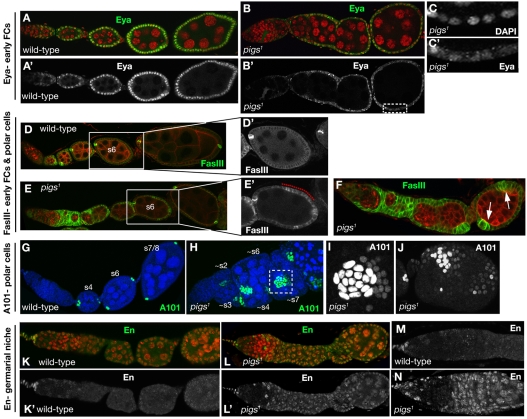Fig. 3.
Follicle cell fate markers are aberrant in pigs1 mutant ovarioles. (A,A′) Eya is the earliest described marker of FC fate and is localised to the nucleus. Eya is maintained in all main body FCs, but is lost from polar and stalk cells once these differentiate in the vitellarium. (B-C′)In pigs1 mutant egg chambers, eya expression was not properly upregulated, and Eya did not accumulate in FC nuclei (C,C′ show boxed region in B′). (D,D′) In wild-type egg chambers, FasIII marks immature FCs in the germarium and young egg chambers until ~stage 4, when FasIII is only maintained in the polar cells. (E-F) pigs1 mutant egg chambers frequently contain more than two polar cells per cluster (arrows in F) and show persisting FasIII expression in the main body FCs beyond stage 4 (E and higher magnification in E′), when main body FCs in the wild-type have lost FasIII (D,D′). FasIII is in green, Shot is in red. (G) A101-lacZ is expressed in two pairs of mature polar cells at the anterior and posterior end of each wild-type egg chamber. (H-J) pigs1 mutant egg chambers contain elevated numbers of polar cells, as many as 18 polar cells at a single pole (box in H that is also shown in I). Extra polar cells were not always located at the poles (J). (K-N) Engrailed (En) is misexpressed in pigs1 mutant ovaries. En labels somatic cap and terminal filament cells in wild-type ovaries (green in K and as a single channel in K′ and M). In pigs1 mutant ovarioles, En was expressed in almost all somatic and germline cells (L,L′,N). Nuclei are red in K and L.

